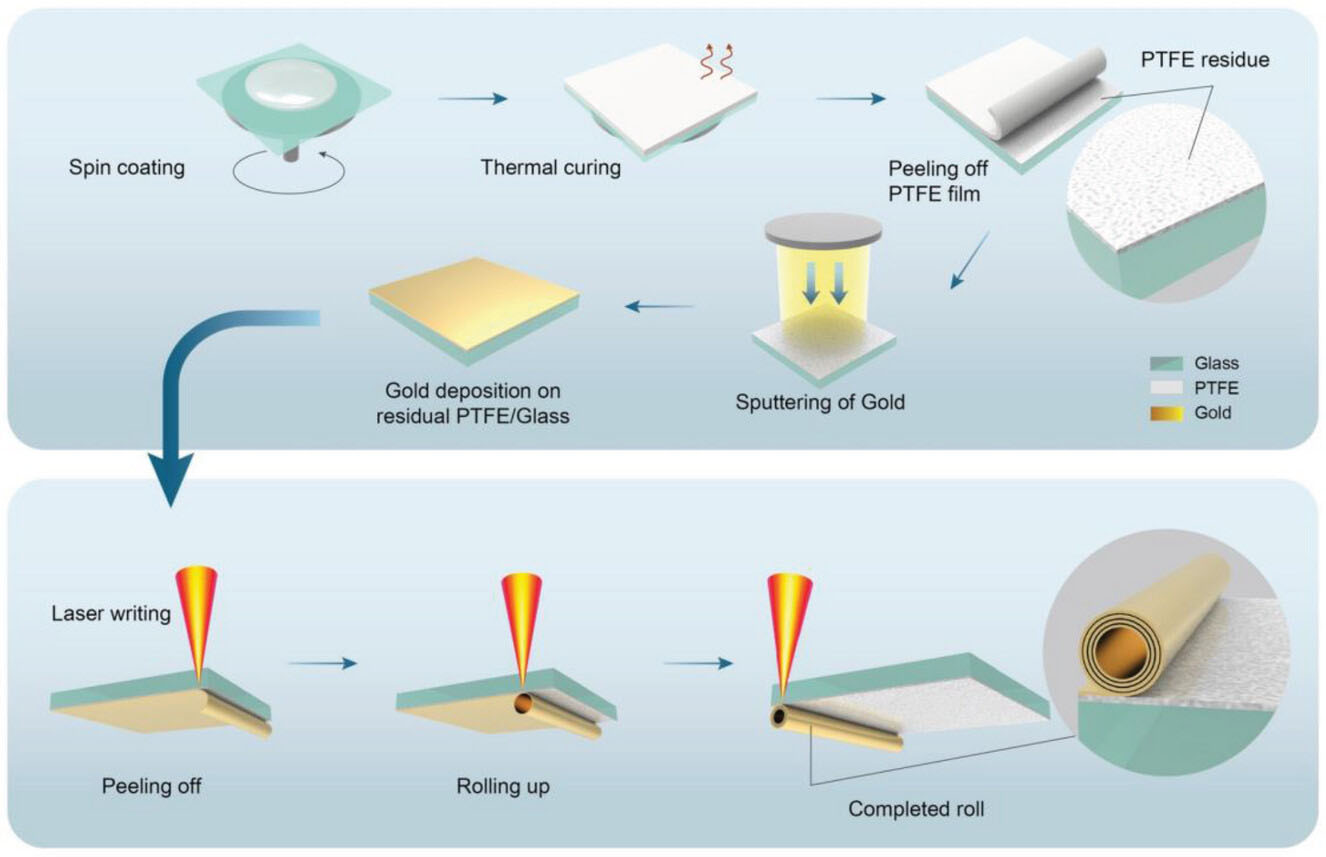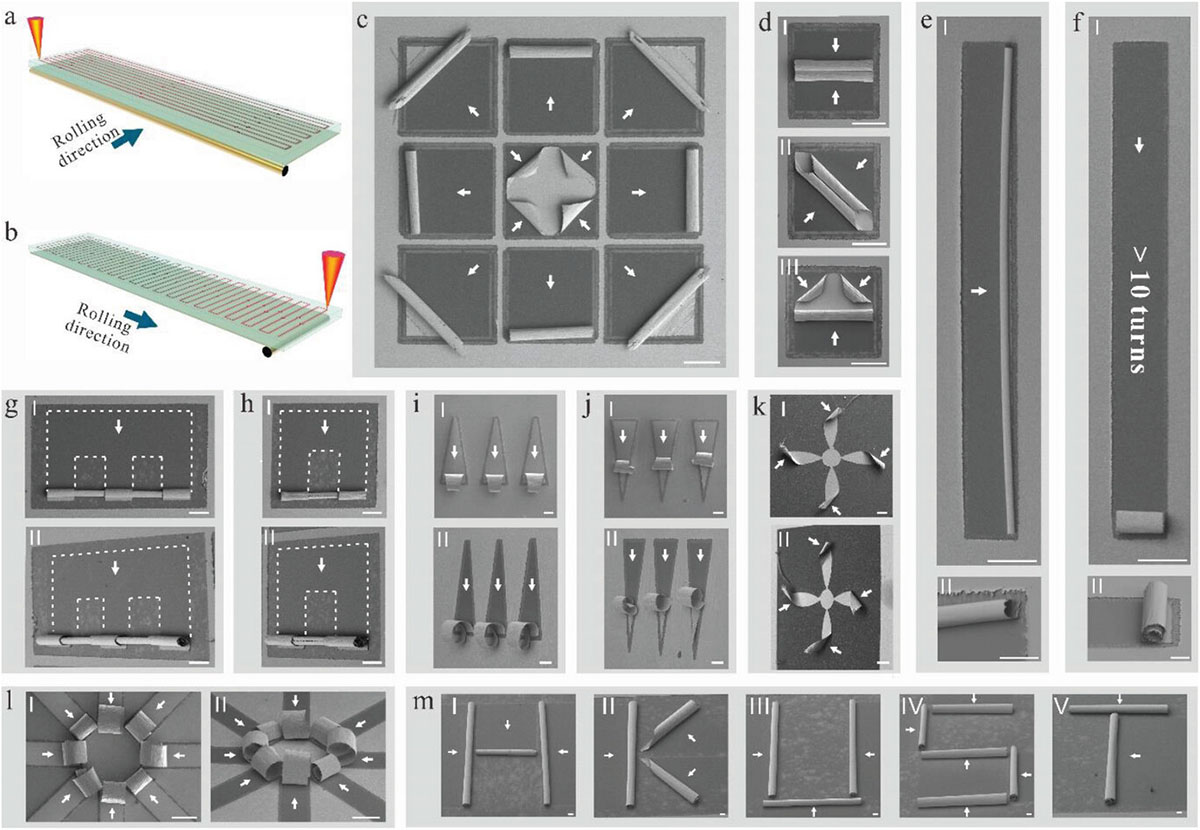| Apr 04, 2024 | |
Laser-guided self-assembly enables precise fabrication of micro-rolls for advanced applications |
|
| (Nanowerk Spotlight) The quest to create intricate three-dimensional microstructures has long captivated scientists and engineers, driven by the immense potential these tiny constructs hold for revolutionizing fields such as electronics, photonics, and biomedicine. However, the journey from concept to reality has been fraught with challenges. | |
| Conventional fabrication methods, while precise, are often complex and costly, limiting their practical application. On the other hand, self-assembly techniques, which leverage the inherent properties of materials to spontaneously form ordered structures, have emerged as a promising alternative. Yet, even these approaches have faced hurdles in terms of control and repeatability. | |
| In recent years, advancements in adjacent technologies have breathed new life into the pursuit of 3D microstructures. The development of sophisticated laser systems, coupled with a deeper understanding of material properties and behavior at the nanoscale, has opened up new avenues for exploration. | |
| It is against this backdrop that a team of researchers from The Hong Kong University of Science and Technology has made a significant breakthrough in the field of self-assembly. | |
| The research, led by Professor Mitch Guijun Li and published in the journal Advanced Functional Materials ("Laser-Guided Self-Assembly of Thin Films into Micro-Rolls"), introduces a novel laser-guided self-assembly strategy that enables the precise fabrication of three-dimensional micro-rolls from two-dimensional thin films. This innovative approach addresses many of the limitations of existing self-assembly techniques, offering a simple, low-cost, and highly controllable method for creating complex microstructures. | |
 |
|
| The illustration of fabrication process flow for laser-guided self-assembly of gold thin film. (Adapted from doi:10.1002/adfm.202400090 CC-BY) | |
| The key to this breakthrough lies in the use of laser scribing to guide the self-assembly process. The researchers began by depositing a thin layer of gold onto a glass substrate coated with a sacrificial layer of polytetrafluoroethylene (PTFE). By carefully controlling the laser parameters, they were able to selectively heat and release specific areas of the gold film, causing it to peel away from the substrate and roll up into a desired shape. | |
| What sets this technique apart is the unprecedented level of control it affords over the final structure. By adjusting the laser power, scanning speed, and pattern, the researchers were able to precisely tune the diameter, orientation, and geometry of the resulting micro-rolls. This level of precision is a significant improvement over existing self-assembly methods, which often rely on global stimuli such as temperature or chemical etching, limiting their ability to create complex, site-specific structures. | |
| The versatility of this laser-guided self-assembly strategy was demonstrated through the fabrication of a wide array of micro-roll designs, from simple cylindrical structures to more intricate patterns resembling pinwheels, zig-zags and letters. The researchers also showed that the technique could be easily scaled up, producing large arrays of micro-rolls with high uniformity and repeatability. | |
 |
|
| Robust control of rolling directions via designing the laser scanning pathway. a,b) The illustration of laser scanning pathways to make a rectangular Au thin film rolling along the short and long sides, respectively. The red lines and small blue arrows indicate the laser scanning paths and directions. c) The SEM image of a 3 × 3 array of square gold thin films rolling in eight directions. d) The controllable rolling of square gold thin films from opposite sides (I), opposite corners (II), two corners, and one side (III). e) The SEM image of a rolled gold thin film of 4 mm × 0.4 mm (rolled along the short side) (I) and side view (55°) of one end (II). f) The SEM image of a rolled gold thin film of 4 mm × 0.4 mm (rolled along the long side) (I) and side view (55°) of it (II). g) The top (I) and side view (55°) (II) of a roll-up m-shape gold thin film. h) The top (I) and side view (55°) (II) of a roll-up n-shape gold thin film. i,j) The top (I) and side view (55°) (II) of roll-up triangle gold thin films. k) The top (I) and side view (55°) (II) of a roll-up gold thin film to form a micro-pinwheel. l) The controllable rolling of eight gold nanostrips to form a flower-like structure. m) The controllable rolling of gold thin films to form the “HKUST” letters. All the white arrows represent the rolling directions. Scale bar (c, d, e-I, f-I, g-l), 400 μm. Scale bar (e-II, f-II, m), 100 μm. (Adapted from doi:10.1002/adfm.202400090 CC-BY) (click on image to enlarge) | |
| Beyond its technical achievements, this research holds immense promise for practical applications. One particularly exciting area is in the field of biomedicine, where micro-rolls could be used as stents for supporting blood vessels. The researchers demonstrated this potential by fabricating gold micro-rolls with dimensions that closely matched those of pig coronary arteries. When inserted into these vessels, the micro-rolls exhibited excellent mechanical stability and fluid flow properties, highlighting their suitability for use as implantable devices. | |
| The implications of this work extend far beyond the specific examples demonstrated in the study. The ability to precisely control the self-assembly of thin films into complex 3D structures opens up a vast design space for creating novel devices and materials with tailored properties. From advanced sensors and actuators to metamaterials with unique optical or mechanical behaviors, the potential applications are limited only by the imagination of researchers. | |
| Moreover, the simplicity and scalability of this laser-guided self-assembly technique make it an attractive option for industrial-scale manufacturing. By leveraging the power of self-assembly, this approach could enable the cost-effective production of complex microstructures that would be difficult or impossible to achieve through conventional top-down fabrication methods. | |
| The development of laser-guided self-assembly represents a major milestone in the quest to create functional 3D microstructures. By combining the precision of laser processing with the spontaneous organization of self-assembly, this technique offers an elegant solution to the challenges that have long hindered progress in this field. As researchers continue to refine and expand upon this approach, we can expect to see a new wave of innovation in fields ranging from electronics and photonics to biomedicine and beyond, ushering in an era of unprecedented control over the structure and function of materials at the micro-scale. | |
 By
Michael
Berger
– Michael is author of three books by the Royal Society of Chemistry:
Nano-Society: Pushing the Boundaries of Technology,
Nanotechnology: The Future is Tiny, and
Nanoengineering: The Skills and Tools Making Technology Invisible
Copyright ©
Nanowerk LLC
By
Michael
Berger
– Michael is author of three books by the Royal Society of Chemistry:
Nano-Society: Pushing the Boundaries of Technology,
Nanotechnology: The Future is Tiny, and
Nanoengineering: The Skills and Tools Making Technology Invisible
Copyright ©
Nanowerk LLC
|
|
|
Become a Spotlight guest author! Join our large and growing group of guest contributors. Have you just published a scientific paper or have other exciting developments to share with the nanotechnology community? Here is how to publish on nanowerk.com. |
|
